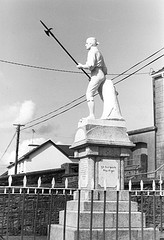Irish Republic (1798)
Irish Republic | |||||||||
|---|---|---|---|---|---|---|---|---|---|
| 1798 | |||||||||
| Status | Revolutionary republic | ||||||||
| Government | Presidential federal republic | ||||||||
| President | |||||||||
• 1798 | John Moore | ||||||||
| Historical era | French Revolutionary Wars | ||||||||
• Arrival of French forces | 22 August 1798 | ||||||||
• Appointment of John Moore as president | 31 August 1798 | ||||||||
• Storming of Killala | 23 September 1798 | ||||||||
| |||||||||
| Today part of | Ireland | ||||||||
The Irish Republic of 1798, more commonly known as the Republic of Connacht, was a short-lived state proclaimed during the Irish Rebellion of 1798 that resulted from the French Revolutionary Wars. A client state of the French Republic, it theoretically covered the whole island of Ireland, but its functional control was limited to only very small parts of the Province of Connacht. Opposing British forces were deployed across most of the country including the main towns such as Dublin, Belfast and Cork.
Proclamation[]
At the time of the Rebellion of 1798 a force of 1,000 French soldiers under General Humbert landed at Killala in County Mayo. General Humbert proclaimed the Irish Republic in his declaration to the people upon landing in Ireland on 22 August 1798:
LIBERTY, EQUALITY, FRATERNITY, UNION, After several unsuccessful attempts, behold at last Frenchmen arrived amongst you... Union, Liberty, the Irish Republic! Such is our shout. Let us march. Our hearts are devoted to you; our glory is in your happiness.
After the nascent Republic's victory at the Battle of Castlebar which took place on 27 August 1798, General Humbert, on 31 August 1798, issued the following decree, which inter alia appointed John Moore as the President of the Government of the Province of Connacht:[1]
Army Of IrelandLiberty, Equality
Head quarters at Castlebar, 14th Fructidor, sixth Year of the French Republic, One and Indivisible.
General Humbert, Commander in Chief of the Army of Ireland, desirous of organising with the least possible delay, an administrative power for the Province of Connaught, decrees as follows:
- The Government of the Province of Connaught shall reside at Castlebar till further orders.
- The Government shall be composed of twelve members, who shall be named by the General-in-chief of the French Army.
- Citizen JOHN MOORE is named President of the Government of the Province of Connaught, he is specially entrusted with the nomination and reunion of the members of the Government.
- The Government shall occupy itself immediately in organising the Military power of the Province of Connaught, and with providing subsistence for the French and Irish Armies.
- There shall be organised eight regiments of infantry, each of twelve hundred men, and four regiments of cavalry, each of six hundred men.
- The Government shall declare rebels and traitors to the country all those who having received clothing and arms, shall not join the army within four and twenty hours.
- Every individual from sixteen years of age to forty, inclusive, is REQUIRED in the name of the Irish Republic, to betake himself instantly to the French Camp, to march in a mass against the common enemy, the Tyrant of ANGLICIZED IRELAND, whose destruction alone can establish the independence and happiness of ANCIENT HIBERNIA.
— General Humbert, Commanding-in-Chief
The rebel republic was a client state of the French Republic and was very short lived. Nevertheless, among the things which President Moore did have time to do was to issue "paper money to a considerable extent...[i]n the name of the French Government".[2]
Defeat[]

On 8 September 1798, just weeks after its proclamation, the progress of the new Republic was ended at the Battle of Ballinamuck. President Moore was captured by the British in Castlebar under Lieut.-Col. Crawford. He died while in custody the following year. General Humbert and his men were taken by canal to Dublin and repatriated. The British army then slowly spread out into the rebel held Province of Connacht in a brutal campaign of killing and house burning which reached its climax on 23 September 1798 when Killala was stormed and retaken with much slaughter. Members of the Irish Republic such as were hunted down and hanged with many other suspected insurgents including Fr Andrew Conroy who led French and Irish forces to Castlebar through the bogs west of Lough Conn.[citation needed]
References[]
- ^ A collection of state papers relative to the war against France now carrying on by Great Britain and the several other European Powers, VII, London: J Debrett, 1799, p. 361, retrieved 28 December 2018
- ^ Ross, Charles (Ed), Correspondence of Charles, First Marquis Cornwalis, John Murray, Albemarle Street, 1859
- 1790s disestablishments in Ireland
- 1798 French campaign in Ireland
- 1798 in Ireland
- 18th-century rebellions
- Former countries in Ireland
- Former republics
- Former unrecognized countries
- Irish Rebellion of 1798
- Irish republicanism
- Rebellions in Ireland
- Resistance to the British Empire
- States and territories disestablished in 1798
- States and territories established in 1798
- United Irishmen
- Wars involving France
- Wars involving Great Britain
- Wars involving Ireland


